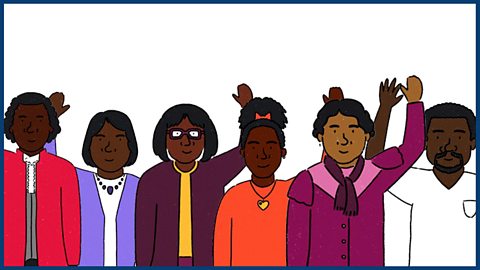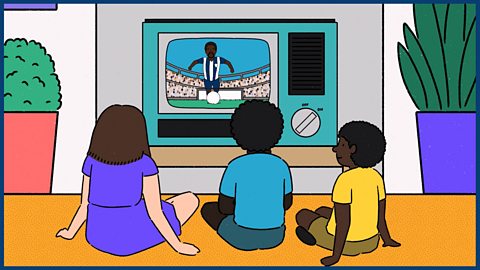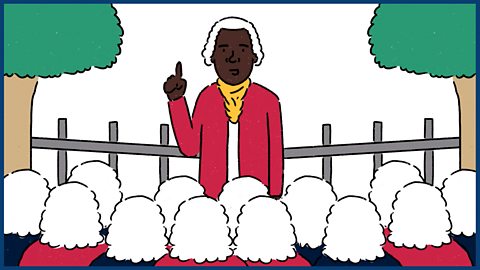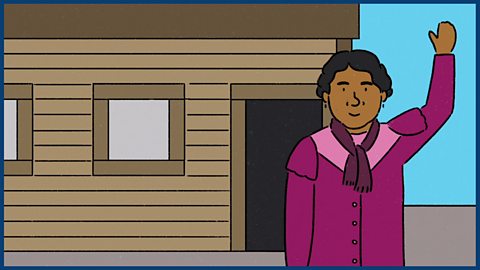Nigel Clarke celebrates the life of Laurie Cunningham - one of the very first black footballers to play for England.
The video
Hi, I'm Nigel. You may know me from the TV. Now, as you can see, I'm black. I was born and grew up in this country, the United Kingdom, but my parents were born and grew up in the Caribbean.
My mum, dad, aunties and uncles moved here from a Caribbean country called Guyana.
There are over two million black people just like me living in the UK. Many of us moved here years ago, and we've worked really hard to make a difference to the lives of people that live here.
This is the story of just one of them, the fabulous footballer Laurie Cunningham.
Back in the 1970s, over 50 years ago, Laurie was one of the first to show us that black British footballers can be very successful. He was one of the very first black players to play for England, so he was an inspiration to so many footballers to be the best they can be.
Laurie's parents, Mavis and Elias, came to Britain from Jamaica, and Laurie was born in London in 1956.
Laurie had an older brother called Keith, and both boys love to play football. Laurie also enjoyed music and dancing. He had really quick feet and was a really good dancer.
When he was 18, Laurie joined a football team in London called Leyton Orient. He was always really fast and everyone thought he was an amazing player. Laurie did so well that three years later, when he was 21, he signed for a very big club called West Bromwich Albion. He joined two other fantastic black players, called Cyrille Regis and Brendon Batson.
At that time, there weren't many black players playing football in the UK, and some people felt there shouldn't be any black players at all. So Laurie, Cyrille and Brendan often had horrible things being said about them just because of the colour of their skin.
But even so, it became obvious that Laurie was one of the best football players in the country. People enjoyed watching Laurie on TV, where they saw him dazzling defenders and scoring incredible goals. He was an inspiration to everyone, especially young black children who dreamt of joining a big football club.
In 1977, at the age of 21, Laurie was asked to play for England. He made history by becoming one of the very first black players to play for his country. It was a fantastic achievement that Laurie had worked very hard for.
When he wasn't playing football Laurie liked to dress up in cool clothes and dance. He would practise his dance moves for hours, doing turns, kicks and even the splits. He was so good that he actually won dancing competitions.
Then in 1979 Laurie joined the great Spanish team Real Madrid. Many superstars like Cristiano Ronaldo would later do the same. But Laurie was one of the first.
He stayed at Real Madrid for three seasons, winning the Spanish league and the cup. When his time at Real came to an end, Laurie came back to England and played for Manchester United, amongst other clubs.
Sadly, Laurie died while he was still quite young, but his influence on football remains enormous. You could say that famous players like Marcus Rashford and Raheem Sterling owe him a great deal.
(Recap) Laurie's story began when his parents moved here to the UK from Jamaica. He lived in London and played football from a young age, but was also interested in music and dance. He inspired a lot of black players and - who knows - if he was alive today maybe we'd be trying to copy his dance moves as well.
Teacher Notes
This video tells the story of Laurie Cunningham (1956 - 1989), one of the very first black footballers to play for England. Laurie began his career at Leyton Orient in London and went on to play for West Bromwich Albion, Real Madrid and Manchester United. Laurie was a winger and his play was characterised by great speed and skill. In his spare time he enjoyed music and dancing.
Before watching the video
Gauge pupils' understanding of football by asking:
- What is a footballer?
- What football teams do you know?
- Can you name any players who play for the England national team currently?
Use a globe to locate some of the cities that Laurie played in - London, Birmingham, Madrid in Spain, Manchester.
After watching the video
Consolidate pupils' recall and understanding of Laurie's story by asking:
- Where did Laurie's parents travel to the UK from? (Jamaica)
- Where was Laurie born? (London)
- What year was he born? (1956)
- Can you name any of the teams that Laurie played for? (The teams include Leyton Orient, West Bromwich Albion, Real Madrid, Manchester United)
- What did Laurie like to do when he was not playing football? (He enjoyed music and dancing)
Activities
Discussion. How do you think Laurie felt when he was first chosen to play for England? How would you feel if you were chosen - perhaps to play football for the national team, or another sport, or another activity?
Discussion. Madrid - the city in Spain where Laurie played football - was a long way from his home in this country. Do you think Laurie would have found it hard to move to Spain? What do you think he would have liked about making that move…and what do you think he may have not liked as much?
Discussion. Laurie inspired many of today's top players. What does it mean to be 'an inspiration'? Why do you think that Laurie was an inspiration to others?
Further resources
Teacher's Notes (pdf) document
Download / print the Teacher Notes to accompany the videos

Image: portrait of Laurie Cunningham. image
Image from the video - click to display image full size

Image: watching Laurie play on the TV. image
Image from the video - click to display image full size

Malorie Blackman (born 1962) video
Exploring the life and work of writer Malorie Blackman, who has published more than 60 books for children.

Olaudah Equiano (1745 - 1797) video
Celebrating the life of the anti-slavery campaigner Olaudah Equiano, once an enslaved person himself.

Mary Seacole (1805 - 1881) video
Celebrating the life of Mary Seacole who journeyed to the Crimean War and cared for British soldiers there.
